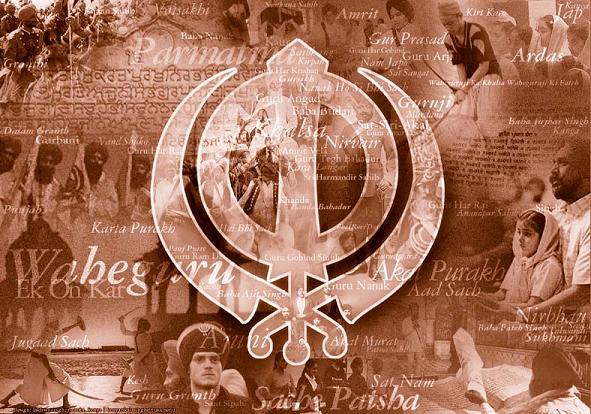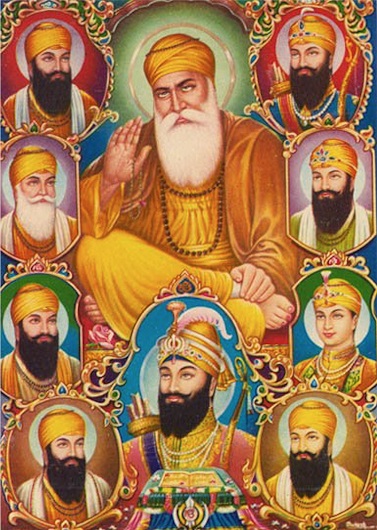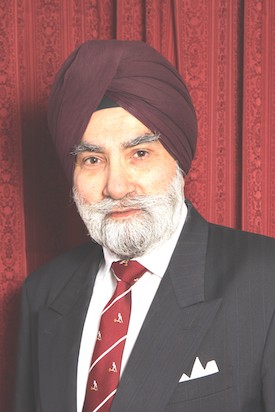“The main substance of this doctrine (of Miri-Piri) is that any sovereign state which includes Sikh populations and groups as citizens, must never make the paranoiac pretensions of almighty absolutism, entailing the concept of total power, entitled to rule over the bodies and minds of men, in utter exclusiveness.”
(Sardar Kapur Singh writing in The Sikh Review of August 1974, The Golden Temple: Its Theo-political Status.)
Some years ago, I had the privilege of translating into English, a Punjabi booklet on Sikhism and human rights which had numerous quotations from Guru Granth Sahib. It was a most rewarding experience. There remains no doubt in my mind that the human rights enshrined in the constitution of the United Nations Organisation, when looked at in the light of the standards set by the Guru, show that the provisions for universal human rights by the modern progressive society fall well short of those provided for in Gurbani and lived in the Sikh historical tradition.
Guru Nanak, the founder of the Sikh religion, raised his voice in defence of human rights and the Sikh chronicle is mainly a long list of martyrs who laid down their lives in the defence of human rights without distinction between religion, caste or creed. Guru Tegh Bahadhur’s martyrdom for the defence of another religion and culture (Hinduism in that case) also laid the foundation stone of the modern human rights movement. Never before had the history of mankind witnessed such a sacrifice. The Sikhs followed the example of the Guru and the Sikh history of 18th century is full of examples of Sikh sacrifices for the protection of non-Sikhs. (I invite young Sikhs world-wide to read this most interesting and adventurous part of Sikh history.) Jo saran aai, tis kanth lai (Those who seek protection (from the Khalsa) shall be warmly received) became the famous motto of the Guru’s Khalsa. All communities could depend on the Khalsa for protection of their just rights. Thus there are numerous episodes in Sikh history when Muslims and Hindus alike came to the Khalsa for protection and help. The distinct Sikh identity ensured that a Guru’s Sikh could not deny his Guru or shirk his religious duty to stand up for the defence of the weak and the downtrodden.
Freeing the Indian society from the evils of the caste system and tyrannical rulers was one of the main objectives of Guru Nanak/Gobind Singh mission.
Guru Nanak Sahib challenged Baabar the Mogul invader:
Addressing his Sikh, Bhai Lalo, said Guru Nanak Sahib,
“O Lalo, he [Baabar] invaded from Kabul with his marauders (“marriage party”) inflicting cruelty and demanding perforce our belongings [chattels and land].
(GGS p 722)
The Guru was imprisoned by the Mogul but released when Muslim religious leaders warned him that “Baba Nanak” (as the Muslims called the Guru) was accepted as a religious guide by Muslims and Hindus alike.
The Guru preached that man’s desire for ultimate salvation could only be achieved through freedom from fear. Fear none and frighten none is a central theme of Gurbani. The Lord is fearless and one reaches Him through total freedom from fear. Struggle for the freedom of all mankind without distinction is a Sikh ideal. However, for universal freedom, high ideals alone are not enough; it is important to play an active part in life to obtain freedom from the fear of oppression, injustice, superstition, insecurity, ignorance and ultimately even death itself. Thus the human rights concept as enshrined in Sikhee goes further than that which is currently accepted by civilised societies.
With this background of Sikh tradition in mind, let us return to Sardar Kapur Singh’s interpretation of the relationship between the Sikh nation and the state administration. What happens if those in power are bent on making “the paranoiac pretensions of almighty absolutism, entailing the concept of total power, entitled to rule over the bodies and minds of men, in utter exclusiveness” ? What has happened since the inception of Guru Nanak Sahib’s struggle for universal human rights? What has happened during the comparatively short history of the Sikhs? What is happening in India today due to political corruption and flagrant abuse of power and a caste ridden social system? And what will continue to happen in future if such conditions continue to prevail? Sikh response, as interpreted by Sardar Kapur Singh in The Sikh Review article quoted above, is as follows:
Firstly, such an oppressive regime “ shall automatically forfeit its moral right to demand allegiance of the Sikhs”.
Secondly, there will be “an eternal antagonism between such a state and the collective community of the Sikhs, represented by the Order of the Khalsa.”
Thirdly, “in this deadly duel the state shall never emerge out as finally victorious, for self destruction is the fruit of the seed of non-limitation, and the status and the prerogatives of the Khalsa are imprescriptible.”
The spirit of freedom through establishment of human rights for all instilled in the Sikhs by the Guru had three aspects. First, the unique combination of faith (dharma) and spirit of independence. Second, for the first time in the history of India the will to struggle for own rights and the inspiration to take possession of political power. The third, the sacrifices of the Gurus and His Sikhs in the front line for the success of the human rights movement started by Guru Nanak, the founder of Sikhism.
Sikh armed response has always been a considered and last resort response to abuse of human rights. That response has always been specific and objective and aimed directly at the evil or oppression which has confronted the Sikhs from time to time. Sikh history and more recent events have clearly shown that Sikhs are not capable of communal violence despite provocation e.g. there was no communal Sikh backlash against the Hindus in Punjab or abroad even when over three thousand Sikhs had been slaughtered in Delhi in November 1984. It is not in the Sikh psyche to attack a community or religious group per se. How can they, for the teachings of Hindu and Muslim Bhagats (saints) are included in Guru Granth Sahib and the foundation stone of Harimandar (Golden Temple) is reputed to have been laid by a Muslim saint. Hindus and Muslims alike have fought injustice side by side with the Sikhs. Indeed at times there were more Muslims fighting tyranny side by side with Guru Govind Singh than his own Sikhs e.g. when Pir Budhu Shah came to the Guru’s help with his seven hundred mureeds (followers) when the Guru was suddenly attacked by hill rajahs at Paunta Sahib. Pir Budhu Shah lost two sons in that battle.
I conclude with a plea to Sikh brothers and sisters to study and understand the relationship between the twin track Sikh theo-political (piri-miri, usually referred to as miri-piri) doctrine and defence of human rights.
Separation of religion from politics suits the priesthood, the Manuwaadic caste system and the corrupt and tyrannical administrators who will not listen to the voice of conscience; it very much suits the priest and the politician both exploiting the public in secret collusion. But such separation, which at times many Sikhs advocate also, is dangerous and will almost certainly lead to a less just and less caring society.
In the UK when the government of the day has become less caring, the Church has spoken out. Defence of human rights needs a theo-political approach which was successfully adopted by Guru Nanak; it was this approach which distinguished Guru Nanak’s Sikhism from the other Bhagti movements of India which were relegated to oblivion over time. It was this approach which freed India from slavery and paved the way for Indian independence.
It is this approach which will bring religion and politics together in harmony in defence of human rights and create a regime in which no one inflicts pain on another, called halemi raj in Gurbani.
* “Guru” is a singular concept for the Sikhs representing the Jot – Guiding Light – of the Preceptor who ultimately is the Timeless Creator Being
© Copyright Gurmukh Singh (U.K.)
E-mail: sewauk2005@yahoo.co.uk
Please acknowledge quotations from this article
Articles may be published subject to prior approval by the author


